
Two Step Up For Students Florida tax credit scholars describe a trip to the Vatican they won't soon forget.
WEST PALM BEACH – A pair of Step Up For Students Florida tax credit scholars took the journey of their young lives recently when they traveled to Italy with the choir from St. Ann Catholic School and participated in the Epiphany Mass, led by Pope Francis at St. Peter’s Basilica in Vatican City.
Seventh-grader Adriana Augustine and sixth-grader Amy Vu described an adventure they won’t soon forget. The St. Ann’s Parish Youth Choir performed six times around Italy during an eight-day pilgrimage that began Dec. 29.
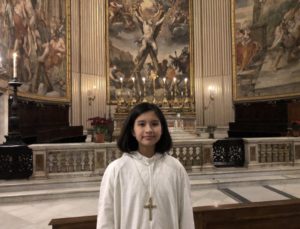
Sixth-grader Amy Vu is a member of the choir at St. Ann’s Catholic School. The choir recently traveled to Rome, Italy, to participate in the Epiphany Mass led by Pope Francis.
“It was a once-in-a-lifetime trip,” Amy said. “It was fun being around all of the other choir members and performing with them in beautiful churches and basilicas. I learned a lot about my religion through all of the tours and visiting the tombs of saints and popes.
“The best experience of all was the chance to get so close to the pope during the papal audience.”
The trip wouldn’t have been possible without the efforts of Chris Hogan, the school’s music director, Principal Susan Demes and a dedicated team of volunteers who helped raise over $125,000 for the trip, Amy said. The choir includes 30 students.
“I had a wonderful time singing in some of the most beautiful basilicas in Rome and Assisi,” Adriana said. “I attended the Epiphany Papal Mass, toured ancient Rome and experienced so much.”
The talented choir was selected to perform after submitting a CD recording of a 2016 performance.
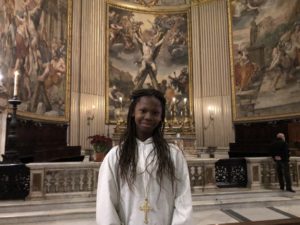
Adriana Augustine, a seventh-grader also on the FTC scholarship, enjoyed touring ancient Rome, where she was mesmerized by the city’s “beautiful basilicas.”
Hogan, the music director, started the choir just over four years ago. He said it grew quickly, and the group was soon singing “quite complex, sacred music.”
“We started performing concerts and eventually recorded a CD,” Hogan said. “Feedback was very positive, and many people both connected and not connected with the group encouraged me to seek out larger opportunities. We looked into an opportunity in Chicago, but eventually determined that the cost with travel was not much cheaper than a more substantial trip, and Rome seemed like a viable possibility.
“Each year at Epiphany, choirs travel to perform concerts and take part in the papal Mass.”
The choir was invited to perform in Italy after Hogan sent a recording and details about the group to the proper Vatican parties. The St. Ann’s choir – with students between ages 9 and 16 – was the youngest of four choirs from the U.S. to perform at the Epiphany Mass.
After the choir was invited, a nine-month fundraising campaign began. There were bake sales and car washes, but the majority of the money was raised through performances at various parishes and Catholic institutions.
“We collected thousands of dollars from regular parishioners around the diocese and individuals who heard and read about our group,” Hogan said. “After these performances, a number of donors stepped in to offer large-scale support to help us achieve this reality. The fundraising was planned and administrated by Jennifer Loyless, an incredibly devoted parent of two choir members.”
Many choir members got to meet Pope Francis.
“That experience was incredibly moving for all of us,” Hogan said. “He was incredibly pleasant, taking his time to hold some of our kids’ hands and even wore a zucchetto – the pope’s cap. We also witnessed him leading the Angelus prayer from one of the windows in St. Peter’s Square.
“The experience was simply remarkable. The kids had an incredible time and parents were in awe of the lifelong memories that were created.”
By Greg Dolan
This Christmas, I am giving thanks for the recent election of so many supporters of the parental right to educational choice for their children. And if I had one wish to improve something for our movement, it would be for private school leaders to be more involved in policymaking and legislative advocacy for that right.
Public school superintendents, teachers (or teacher union officials), and school board members are the leaders in public debates over district school spending and regulations. In the debates over educational choice, however, think tank staff, professional lobbying groups, and tax-credit-funded scholarship organizations are usually leading the charge. The former group more earnestly represents the local community – adults entrusted with children for seven hours a day and neighbors selflessly serving on school boards. Meanwhile, the latter appear as outsiders – anti-public-school hired guns employed by the rich to create more tax benefits for the rich. These perceptions are unfair, as the former are not so disinterested and the latter’s financial benefit is paltry, but whoever said education choice proponents get a fair shake?
 If the face of our movement became superintendents, principals, and teachers at private schools (instead of policy wonks), we would improve not only perceptions but also the details of policy.
If the face of our movement became superintendents, principals, and teachers at private schools (instead of policy wonks), we would improve not only perceptions but also the details of policy.
There are professional organizations already doing some of this work. In the Catholic schools world, the National Catholic Educational Association is a member-organization for Catholic school professionals. Organizationally, they are outspoken advocates for choice in education. But that does not mean every member is out there speaking up for the cause.
As a concrete example, when an education savings account law with universal eligibility was up for referendum in Arizona, private school teachers were not marching the streets of Phoenix in support a la the #RedForEd episode. Instead, professional education choice advocates from national organizations were the ones defending the law with a failed attempt at “#YesforEd”, and their lawyers were making the most concerted effort to stave off repeal. Where was the fire and fury of thousands of teachers who wanted the chance to change lives? Where were the principals who had made space at their school in anticipation of the new law? (Perhaps some of this did happen in Arizona; I was not a perfect witness to the entire saga. But writ large, these types of things do not happen when proposals are attacked and choice programs are threatened.)
Our professional advocates also do excellent work highlighting the individual stories of families benefiting from educational choice. But there is a limit to the effectiveness as the parents are not the schools – and it is often the schools that are attacked as dubious indoctrination camps (redefinED readers are well aware of the Orlando Sentinel’s zeal for this task).
According to my organization’s analysis of 28 different education choice programs in 20 states, released this month at EdNext and available on our website, about 1-in-5 students in those states are at a Catholic school due to a voucher or tax-credit-funded scholarship. These students are integral parts of their schools, contributing to and benefiting from the community. But only the school staff can tell that story convincingly. Lobbyists, think tank presidents, and media consultants will never be as believable as the staff who see the growth of these students and their impact on their peers. Teachers especially could put a human face on the care and attention they give each student regardless of how their tuition is paid. They are the real frontlines to the education choice fight.
Administrators could also be helpful in dissuading allied legislators from injecting burdensome and distracting provisions into choice legislation. Too often, lawmakers (and some policy wonks) are underprepared to counter the attacks on a choice program, leading them to offer unnecessary amendments to a bill in the hopes of quieting opponents’ objections. If they knew more about the relevant operations of the private schools likely to participate in a new program, they would be able to counter opponents more effectively.
But who can blame our legislative allies? When the lobbyist informing you about education choice one day is giving advice on business tax cuts the next, no wonder the details do not settle in. How much better would it be for school leaders and teachers to equip lawmakers with anecdotes of how a voucher student fit in and contributed to the classroom — or better yet, to that choice student’s learning success? To have that teacher offer heartfelt and passionate testimony at a panel hearing, instead of a numbers-and-figures talk from a paid advocate, would offer true insight into the efficacy of the program and disarm the opposition of its most relied-upon resource, public school teachers.
As the New Year and new legislative sessions approach, I remain thankful for my fellow advocates who do so much good and effective work for education choice. And if I had a Christmas wish, it would be to engage more private school teachers, principals, and administrators to replace us non-teachers as the face of education choice advocacy.
Greg Dolan is Director of Policy and Outreach for Catholic Education Partners.
Editor’s Note: This is the eighth in a series of posts where various members of the education choice world share an #edchoice wish. For Monday's post, CLICK HERE.
COMING TOMORROW: Step Up For Students' Lorraine McBride explains why education choice kept her from being just another statistic.
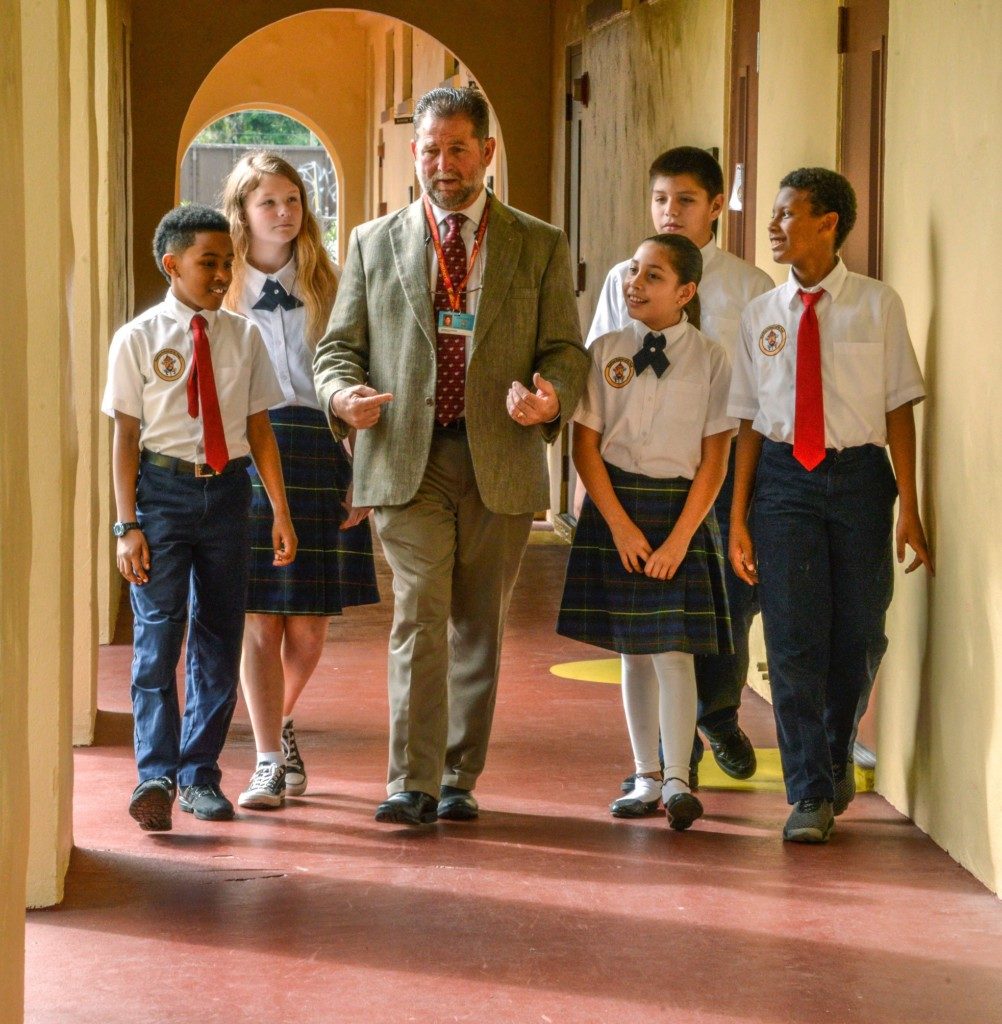
Ron Pagano walks the halls with students at Basilica. Since taking over the school he attended as a child, test scores are up, and discipline problems have been curbed.
Students at Basilica School of St. Paul were scoring in the lowest 20th percentile on the Iowa Test of Basic Skills in 2016. Many also had disciplinary problems. There were discussions about closing the PreK-12 school in Daytona Beach.
Meanwhile, Ron Pagano, was weighing his next career move as he chose to retire from 36 years in the Volusia County traditional public-school system. And Basilica, which he attended as a young boy, had a special place in his heart.
“This is where I needed to be,” Pagano said. “I love being part of the community. I could be the change agent they needed to help.”
Since Pagano took over the helm as principal in 2016, students are performing at least 10 to 15 percentage points higher on the Iowa test and discipline problems have been reduced. Pagano changed the curriculum and hired five new teachers. He also began administering Measurement of Academic Performance assessments, a computer-based adaptive standardized test from the Northwest Evaluation Association that his students took three times a year to measure growth and achievement.
“We are monitoring as a school and teachers are more in tune with what is going on in the classroom,” Pagano said.
In the past school year, 77 percent of students made improvements in math and 64 percent in reading on the MAP, according to Lauren Barlis, director of learning management for the Office of Student Learning at Step Up For Students, which administers the Florida Tax Credit Scholarship and publishes this blog. Step Up For Students formed a partnership with NWEA in administering the assessment and supporting teachers and administers in using the data to inform their instruction.
Pagano said 90 percent of students at the school receive the Tax Credit Scholarship for low-income students.
Applying his lessons
Pagano remembers many of his teachers from his days as a student at Basilica.
“When I was there, I was not the best student,” he said with a chuckle. “I do remember being pushed by my teachers.”
His teachers instilled in him the importance of reading, which he hopes to pass on to students now. He challenges young male students, who sometimes prefer sports over reading, to find a balance.
During his high school years, Pagano became interested in education.
“My high school head football coach, Jim Kirton, was my inspiration and mentor,” he said. “He instilled in me a love for coaching on the athletic field, which I parallel to the classroom. And he loved his students more than the curriculum he taught.”
Teachers and parents say Pagano, like his mentor Kirton, is an active participant in the school. He leads the morning assembly and sets the tone for the day.
Walking to class through the domed archways on a recent day, students perked up when they saw Pagano, wishing him a happy early birthday. Pagano said he views the school as not only an education institution but an extension of the community. He has participated in an outreach program that helps bring food for families in the school. He also helped one parent find housing before becoming homeless.
Claudine Khouri, a disabled vet, choked up when she spoke about how Pagano helped her find a place to live. Of the school, Khouri said, “it is an extended family.”
Khouri said Pagano has remained in touch since her son, Kayvon, has been in and out of the hospital. Pagano connected him with tutoring services. He also intervened when her son was bullied.
The school serves 197 students who are all on free and reduced lunch. Forty-two percent are black, 38 percent are Hispanic, 12 percent are white, and 8 percent are Asian and other races.
Erin Roszak, who teaches second grade at the school, said when she struggled teaching a difficult class, Pagano took time to sit with her and offer advice.
“He is constantly pulling us to grow and get better,” she said.
And Lee Ann Brown, who teaches middle school math, said Pagano is a hands-on educator and is always coming up with ways to think outside the box.
When Pagano learned that students in Brown’s math and sciences classes were struggling, he split the classes, so students were able to have more one-on-one help from teachers.
“He gives us the autonomy to implement his ideas and expectations in a way that works with our specific classrooms,” Brown said. “Allowing us to take into account our personalities and the personalities of our students makes trying something new feel less daunting.”
Coming full circle
Pagano began teaching in 1980 as a biology and physical education teacher at Mainland High School in Volusia County. Several years later, he became assistant principal, serving at three schools in the county. In 1995, he became principal at Holly Hill Middle school and then two other Volusia schools before retiring in 2016.
During his time as an educator in the traditional public-school system, Pagano said he had misconceptions about private schools. He was under the impression that traditional public schools were losing money because private schools were siphoning funds away from those schools.
But when he became principal of Basilica of St. Paul, his view changed, especially when learning most of his students use the FTC scholarship. The state gives dollar-for-dollar tax credits to companies that contribute to nonprofit scholarship organizations to fund the K-12 income-based scholarships. A series of state studies have determined the scholarships save tax money that can be used to help traditional public schools.
“There is no doubt that it changed my viewpoint where funding comes from and where it is not being taken from,” he said.
Prior to serving at a Catholic school, Pagano also believed private schools did not have financial needs. That view also changed based on his experiences at Basilica. His school is in an urban area and the parish is not as strong financially as it was years ago.
Pagano said he wants to continue to move the school ahead and to sharpen his focus on parental involvement. “I am really trying to get the kids to understand their role as a learner,” he said.
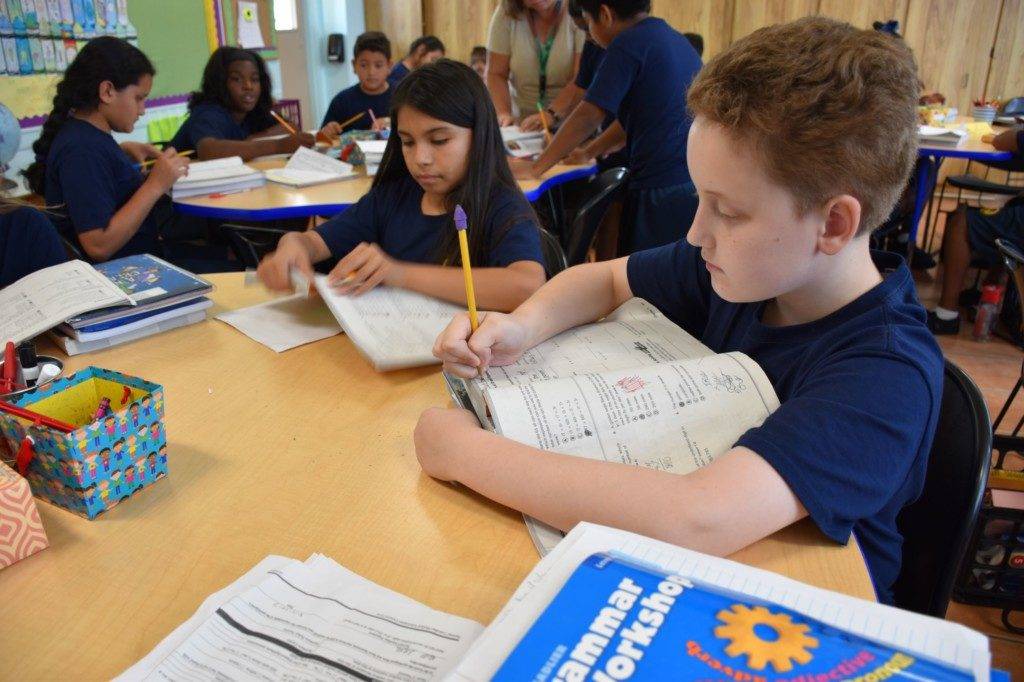
Students at Lourdes Academy have begun participating in the Program for Inclusive Education (PIE) for students with specific learning needs or diagnosed disabilities.
The losses were small but concerning. On average each year, two students with learning needs were leaving Lourdes Academy in Daytona Beach.
Like many other Catholic schools, Lourdes simply did not have a full-time staff person to help meet the needs of those students. According to principal Stephen Dole, that deficit made it hard for the school to identify the students and the interventions they may need.
“When you think of 225 students you have and out of those 25 are struggling, that is a decent number you have to allocate resources to,” he said.
When Dole learned of the Program for Inclusive Education (PIE) at the University of Notre Dame’s Alliance for Catholic Education, he thought the program was just what the school needed. PIE trains teachers to identify students with specific learning needs or diagnosed disabilities and directs them in implementing evidence-based practices that have been proven effective for struggling learners. The 13-month program allows teachers to become certified in exceptional needs and mild intervention.
Lourdes was the first of three Catholic schools in the state to complete the program, which was founded in 2016. In total, 32 schools in 16 states have participated.
Now, there are two teachers certified at Lourdes to deal with mild to moderate interventions, one of whom is dedicated full-time to meet the needs of struggling students.
“We are hopeful to be able to retain the students,” said Dole. “We want them to be on grade level before they graduate. We want to continue to meet the needs of as many students as possible.”
According to the University of Notre Dame, 87 percent of dioceses surveyed report that schools do not have the capacity to meet the needs of students with learning differences. The National Center for Education Statistics also reported in 2017 that 78.4 percent of Catholic schools serve students with mild to moderate special needs.
Overall, 5.1 percent of students in Catholic schools have a diagnosed disability, according to the National Catholic Education Association.
Amy Matzke, director of student support at Lourdes Academy, said that prior to the PIE training the school struggled through trial and error to find the best interventions for those struggling students. Matzke said now she has evidence-based protocols that guide her through her curriculum-based measures that are targeted to each student’s needs.
Matzke leads a team of paraprofessionals who can pinpoint struggling students and determine the best solution for them: intervention, another teacher in the classroom or a small group setting.
“We are able to look at an actual behavior or learning issue,” Matzke said. “We are able to decide why this happened, what we need to do to fix it and implement it right away. “
Lourdes serves 225 students, of whom 145 use the Florida Tax Credit Scholarship for low-income students. That scholarship is administered by nonprofits like Step Up For Students, which publishes this blog.
The school was chosen as a National Blue Ribbon School in 2006 by the U.S. Department of Education. When the economy weakened in 2008, many parents pulled out their kids, said Dole.
When Dole became principal in 2016, he implemented a higher measure of accountability for students and parents. He brought on a full-time curriculum coordinator to strengthen the curriculum working directly with teachers to implement best practices. Personnel changes were also made.
The school currently includes students from all backgrounds: 50 percent are white; 25 percent Latino; 20 percent black; and 5 percent Asian or mixed race.
Since changes were implemented in the last three years, students have continued to make academic progress, scoring well above the national average of 50 percent on Iowa assessments, according to Dole.
Beyond Lourdes Academy, the mission of PIE is to equip Catholic schools with the culture, foundation and resources for educating all students inclusively while celebrating every student’s diverse and exceptional characteristics, said Christie Bonfiglio, director of PIE and director of professional standards and graduate studies at Notre Dame.
“PIE advocates for empirically-validated instruction so teachers are implementing what works,” Bonfiglio said. “In addition, we train teachers to collect valuable data and to make good decisions based on the evidence.”
Historically, Catholic schools have been slow to open their doors to students with diagnosed learning needs, Bonfiglio added, but “now we are seeing more advocacy and a bigger push to serve academically diverse students in all schools.”
Notre Dame began supporting the mission of inclusion through the Teaching Exceptional Children Program in the summer of 2010. The program was revised over the years to better meet the needs of struggling learners and students with disabilities.
“Nationally, academic diversity is prevalent in all schools,” said Bonfiglio. “That is, there are struggling learners and students with disabilities (diagnosed or not) in the classrooms in Catholic schools across the country. It is our responsibility as Catholic educators to welcome these students and ensure that their needs are met.”
Editor’s note: To mark National Adoption Awareness Month, RedefinED is highlighting a choice scholarship that serves children who are or were in Florida’s foster care system.
INVERNESS, Fla. – There is no hiding from the nightmarish stories of his early childhood, but Diego Cornelius is grateful to have forgotten most of the details.
Some things he can’t forget, like the time he smelled smoke in their mobile home and woke everyone, saving them, before all of their possessions burned. Or the time he fell from a boat without a life vest, and nearly drowned before his mom jumped in.
Most of the time, he and his sisters were left alone. Their father was gone, their mother addicted to a variety of drugs. Her extended family and boyfriend had lengthy criminal records.
“He always had a struggle to survive,” his adoptive mother said.
These days, 13-year-old Diego is grateful for a lot of things: his younger sisters, Alyssa and Bianca, who look to him as a role model; his former foster parents, who adopted them; and the school choice scholarship that’s allowed them to attend the Catholic school that has embraced them all as family.
X X X
As a foster mom to more than 100 children over the last 22 years, Patricia Sobel knows something about the importance of a caring, structured environment.
That’s why she lit up when she learned about the Step Up For Students scholarship that empowers low-income families to send their kids to the private school of their choice. The scholarship also serves foster children and adopted children who were in Florida’s foster care system. (Editor's Note: Step Up publishes this blog.)
“I was in shock,” she recalled. “Shock, for two days. I couldn’t believe they were actually eligible for this free education. What a gift!”
When Diego, Alyssa, and Bianca entered Patricia’s life, she realized they were special. Six years ago, they were rescued from a life of severe neglect.
“They were living in a drug house,” Patricia said, her low, soft voice punctuated with warm emotion. “They were in a garage with no running water or electricity. Their teeth were blackened. Their heads were filled with lice. They were so filthy, they had to be bathed at the police station.”
Diego remembers the lice crawling under the tight waves of his reddish-blond hair.
“We had to put mayonnaise in our hair and wear caps over it,” he said. “I still think about that. It means someone is there to care for you and make sure you’re healthy.”
That was just the start. Diego needed a surgical procedure on his eye, and all three children needed counseling and dental work.
For kids who had so little growing up, even small gestures made a big impression.
“If I’m hungry, I just go ask and they ask me what I want,” Diego said. “They make sure we don’t starve. They make sure to protect us. My mom likes to lock the doors each night and make sure the windows are closed.”
“They love us.”
It took time for Diego and his sisters to go from “Pat” and “Chuck” to “Mom” and “Dad,” but now the love is mutual.
X X X
The children have gotten used to the same love and care at Saint John Paul II Catholic School in nearby Lecanto.
“I like the teachers, all of them,” said Alyssa, 11. “They’re kind and they help us.”
Bianca, 10, enjoys learning about religion, something else that was missing in their early years.
None of the siblings attended preschool, and Diego still feels the effects of being behind academically. His biological mother took him to kindergarten for the first week but never brought him back. He doesn’t know why.
When Pat and Chuck sent him to their neighborhood school, Diego was a 6-year-old in kindergarten alongside 5-year-old Alyssa. They remain classmates today.
After a couple of years living in the Sobels’ four-bedroom foster home in Tampa, everything fell into place for adoption. The children’s biological parents no longer had rights to custody. Despite their troubled past, the siblings were vibrant, compassionate, and healthy.
A few months later, Patricia and Charles moved everyone north from bustling Tampa to the rural rolling hills of Inverness to start Don Bosco’s Children’s Home, named after John Bosco, a Catholic saint who dedicated his life to helping disadvantaged youth. The nonprofit had purchased three houses and the lush, tranquil land they sat on. It needed a lot of work – a new roof here, a new air conditioning system there, paint and landscaping everywhere.
The Sobels know how to rehabilitate.
Their organization is still getting off the ground. Their goal is to find foster parents to live in the other two houses, to use their home as a blueprint. The need is large and growing.
“I get calls every day to place kids in foster care,” Patricia said.
The number of children entering Florida’s foster care system has risen sharply, and a recent study by the University of South Florida showed a tie to the opioid crisis.
“I’m going to continue taking more children,” Patricia said. “One thing I try to do is get them all in the Step Up For Students program.”
In the three years they’ve lived in Inverness, they’ve sent all 13 of their children to Saint John Paul II. Patricia has fond memories of her biological daughter, Adrienne, attending Catholic schools. More importantly, she feels a small school with a more individually tailored environment is best for her foster and adopted children.
X X X
Earlier this year as a sixth-grader at SJP2, Diego got in trouble for plagiarizing a paper. His teacher was ready to give him an F. The principal intervened.
“He wasn’t trying to do it on purpose, he just had never been taught the proper way,” said Lee Sayago, himself an energetic newcomer at the school.
Diego was upset. Getting all A’s and making the Principal’s List was a borderline obsession from the time he first attended an assembly and saw his high-achieving classmates receive special recognition.
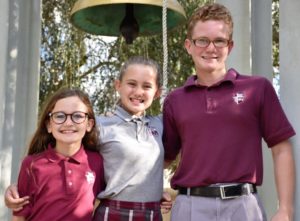
Bianca, Alyssa, and Diego Cornelius are all smiles at Saint John Paul II Catholic School in Lecanto, Fla.
He got a second chance and beamed with confidence when he pulled Sayago aside to show him his new grade – 97, the highest score of anyone in Grades 6-8.
“It could have been a negative experience,” Sayago said, the corners of his eyes creased with pride. “But the way he handled it was amazing.”
Diego is in the midst of a growth spurt. He loves sports that involve running and lifts weights regularly in hopes of getting “six-pack” abs. After a couple of years of falling just short, he’s made all A’s.
“It’s amazing what a little nourishment and love can do,” Patricia said. “It comes from the home and the school, and then they just grow and blossom.”
About Saint John Paul II Catholic School
Opened in 1985 as part of the Archdiocese of St. Petersburg, St. John Paul II is the only Catholic school in rural Citrus County. The school serves 205 K-8 students, including 81 on Step Up For Students scholarships. SJP2 is a candidate school for the International Baccalaureate Middle Years Programme and is pursuing authorization as an IB World School. The school administers the MAP Growth test three times a year as well as the Terra Nova Spring test. Annual tuition is $6,645 for K-5 and $6,945 for 6-8.

Alumni from Cardinal Newman High School, returning as faculty. Many Catholic school students return to teach at their alma mater - drawn back by the bond of community and religion.
Anxious thoughts flooded Joe Molina’s mind.
He was navigating his first day of teaching Spanish at Cardinal Newman High School, a Catholic school in West Palm Beach.
Cardinal Newman was no ordinary school. Molina was a student at the school nine years earlier. That spring day, he was overwhelmed and reached out to his mentor and former teacher, Susanne Escalera, for help. Now a fellow colleague, she told him to take several deep breaths and relax. He then could face the classroom.
Those kind words reminded Molina where he had found himself: back at home.
Molina’s story is not uncommon. Many Catholic school students return to teach at the very schools they attended. They are drawn back, in part, by the bond of community and religion. Molina forged relationships at Cardinal Newman that have lasted nearly a decade.
As a student, Molina overcame his hurdles in calculus with the help of a teacher, Christine Higgins, who is now the principal. And when he tore his ACL and dislocated his knee cap in high school football, his coach, Don Dicus, stood by his side, reminding him that no matter how hard it gets, it was essential to go forward.
Now in addition to teaching Spanish, Molina is the football coach at Cardinal Newman, hoping to teach the same values he learned in high school to the next generation of students. (more…)